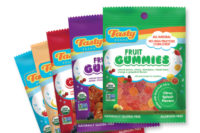Organic. All-natural. Non-GMO. These labels are popping up everywhere — and while the majority of the organic industry applies to fruits and vegetables, growth is being seen in other food categories, including candy and snacks.
In fact, according to a 2013 study by the Organic Trade Association (OTA), organic snack food had seen a 15 percent increase in consumption, making it a $1.7-billion industry. Additionally, overall organic product sales in the U.S. reached $35.9 billion in 2014, an 11.3 percent increase from the year before according to OTA.
But before we take a look at how this is affecting the confectionery industry, a quick refresher. After all, a lot of consumers can’t even tell you what, “organic” means. According to a study by BFG, of the 76 percent of consumers younger than 35 who are concerned about what’s in their food, only 30 percent can define the term.
Officially, “organic” means that the produce or ingredients used in a product are grown without pesticides, synthetic fertilizers, sewage sludge, genetically modified organisms (GMOs), or ionizing radiation.
The “all-natural” label is a bit trickier though, because there is no FDA definition and therefore no certification involved. However, the FDA does not object to this label if there are no added colors, artificial flavors, or synthetic substances.
And “non-GMO” means exactly what it sounds like — the product isn’t or doesn’t include genetically modified organisms. A non-profit organization called the Non-GMO Project certifies products that meet the mark.
So, what does this look like in practical terms? After all, trends don’t always have a strong basis in fact or knowledge. What’s behind the hype?
As it turns out, a lot.
Organic foods are healthier for consumers, farmers, and the planet, says Cathy Fichtner, category manager for chocolate, cocoa, & caramel, Global Organics, Ltd.
“Organic production reduces exposure to toxic and persistent chemicals in the foods we eat and for farm workers and their families,” she explains. “Organic agricultural methods also reduce contamination of the soil, air, and water in farming regions. There is increasing evidence that organically grown foods are rich in nutrients, such as anti-oxidants, vitamin C, iron, magnesium and phosphorus.”
There is also evidence that pesticides and fertilizers, commonly used in non-organic food production, can have a negative impact on consumers and farmers, says Edouard Rollet, co-founder and co-ceo, Alter Eco Americas, PBC.
“Farmers’ health can be equally affected from inhalation of these chemicals and their land can be damaged,” he says. “We’ve witnessed the damage firsthand with our jasmine farmers in Thailand, who have converted their crop to organic more than a decade ago, but still suffer from respiratory problems, resulting in frequent hospital visits.”
And creating foods that meet these standards has to be a joint effort — from field to fork. Today, corporations, consumers, and farmers all play a role in making food and food production better for everyone. The organic sector is growing at 10-25 percent a year, and many companies are confident the industry will continue to blossom.
“There are so many over-processed foods and we want to [offer] something that’s all-natural, pure, delicious,” says Deborah O’Kelly, ceo, Golden Girl Products, LLC. “People are health-conscious. People [used to] eat something because it was convenient. Now people are really reading their labels. I think it will be something that will stay with us now.”
But, as with most worthwhile endeavors, sourcing organic and all-natural ingredients come with bumps in the road, and the process can be trying, something Rollett has learned first hand at Alter Eco, which makes chocolate, quinoa, and rice products.
“We take the time to craft our chocolates through a process that can take five to ten times longer than creating most other bars, but the end result is incredibly incomparable and a superior taste comprised of elevated flavor profiles and texture that consumers enjoy,” he explains.
Amanda Reiss, cmo, Unreal, faces the same issues.
“It’s a very challenging process, because sourcing ingredients is difficult. Sometimes, certain ingredients are rare and in low supply,” she says. “Sourcing these ingredients is also much more costly, so companies need to find a balance between using the right ingredients and charging the right prices.”
Getting the official labels can also be difficult, something Fichtner at Global Organics knows first hand.
“Organically grown and processed ingredients follow very strict guidelines governed by the USDA and certified by the National Organics Standards Board,” says Fichtner. “Organic operations must demonstrate that they are protecting natural resources, conserving biodiversity, and using only approved substances.”
Golden Girl also uses non-GMO ingredients in their line of tasty, homemade, all-natural granola mixes, and they deal with the same obstacles.
“People don’t want GMOs. It changes the molecular structure of the food. We use non-GMO canola oil, which is more expensive. Chocolate has been the most difficult [to obtain],” O’Kelly says.
Fichtner says Global Organics has seen more and more confectioners looking to use only clean and pure ingredients.
“Organic ingredients fit this need and have the certifications and traceability to prove their lineage,” she says. “Many bean-to-bar chocolate makers are using organic chocolate liquor, organic cocoa butter and organic cane sugar to produce chocolate that consumers want because they are contributing to saving the earth and helping farmers.”
Global Organics manufactures ingredients, many of which apply to the confectionery industry including organic cane sugar, organic cocoa and chocolate, and organic fruit purees and concentrates. They meet the standards of the National Organic Program (NOP), the Canada Organic Regime (COR) and European Union (EU) organic standards according to their website.
Hillside Candy’s GoOrganic brand is also dedicated to excellence in organic candy and snacks. And they’re veterans in the business, having had the organic label for over ten years. They use real organic fruit purees in their Fruit Snacks, and use no GMO’s or preservatives. And they’re sure to keep their ingredient lists short and delicious.
For example, their hard candies, which come in exciting flavors such as Ginger Xtreme, Blood Orange, and Iced Mint Mango, only contain a handful of ingredients, including natural flavors and organic brown rice syrup.
The GoOrganic line extends to include Ginger Chews, Fruit Chews, and hard candies, all of which are organic and non-GMO.
“Obtaining Non-GMO Project Verification for our entire line of candies was important to us – and to our customers. GoOrganic is committed to providing health-conscious consumers and their families with tasty treats, and also the peace of mind that we are committed to sourcing the highest quality, cleanest ingredients available,” says Sandy Gencarelli, director of marketing and export sales, Hillside Candy.
For Alter Eco, it’s all about putting good into the world.
“The conventional food industry has plateaued throughout the years, and mainstream conglomerates are continuously seeking to merge and acquire innovative sectors,” says Rollet.
“[Alter Eco’s] commitment to using organic ingredients and Fair Trade practices in regions outside of Africa — which is threatened by weather, disease and socio-economic issues — has helped enable us to successfully use sustainable cacao growing techniques for a happy, healthy planet and happy, healthy consumers.”
Happy customers is right. As Reiss points out, “while we go out of our way to source the best ingredients, taste is of huge importance to us. We believe that even your treats should be better for you — with no artificial ingredients or colors. It’s possible to use the best ingredients AND taste delicious!”
Certainly, for a growing number of consumers, organic, all-natural, and non-GMO seem to be the way to go.











